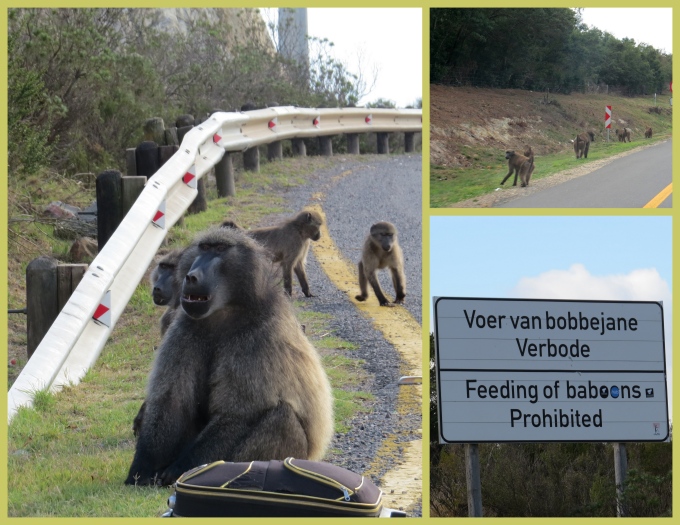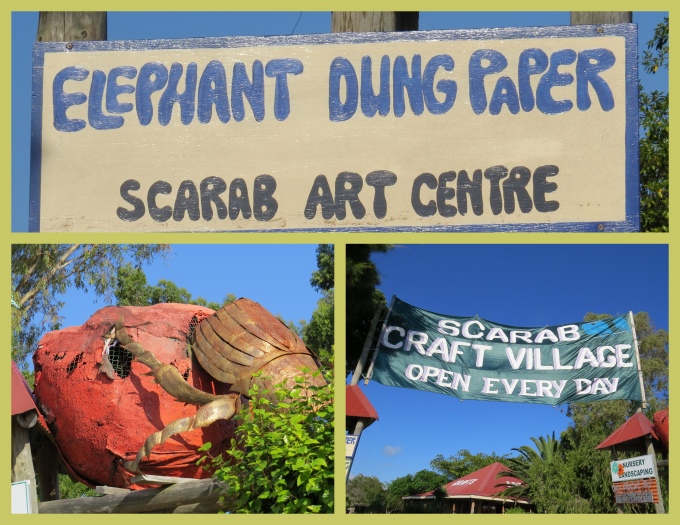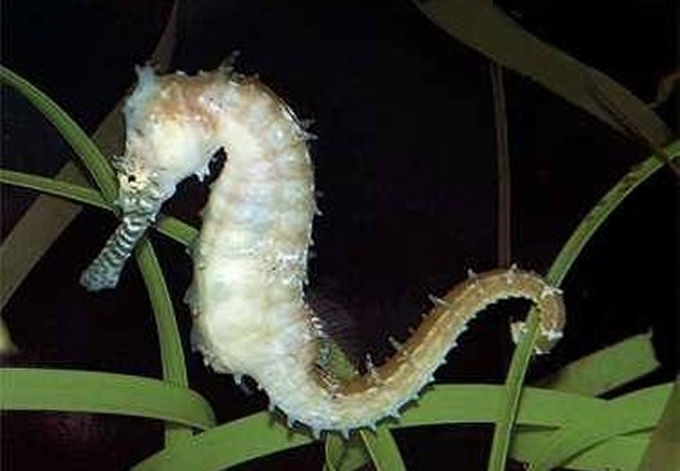A Night in Knysna
/...and all we didn't see
Knysna (Nighs-nah) is a small coastal town about 500 km (300 miles) east of Cape Town. It's a long story why we drove 300 miles to a place we had passed by in Nine of Cups, but suffice it to say, it's a lovely place and we enjoyed the ride there, which was much faster by car at 120km/hour than by boat at 5 knots/hour. We went over Sir Lowry Pass through the Hottentots-Holland Mountains. We had to watch constantly for baboons as they were all over the road for quite a stretch. Don't ask me why one baboon in the picture has a suitcase. No clue. Perhaps going on a trip?
The landscape changed from mountainous to rolling hills with vineyards and apple orchards and then the rolling hills were brown, furrowed fields newly planted with winter crops or crowded with lambs and newly shorn sheep. The brown soil became iron-rich rusty red and the sheep were joined by goats and ostrich. In one field, we spotted blue cranes, South Africa's graceful national bird.
We're not fast travelers. We stopped for coffee and then we stopped to stretch our legs and get rid of the coffee and then it was time for lunch. We stopped for gas next to the Scarab Art Centre which boasted a huge dung beetle complete with dilapidated dung ball at its entrance. Perhaps this is the world's largest dung beetle and ball … I'm not sure. Elephant dung paper was advertised, but the place which claimed to be open every day (except today) appeared closed, so we couldn't investigate. Imagine elephant dung paper as your official stationery. What a souvenir … much better than biltong or a t-shirt.
Knysna is a charming, touristy kind of place on the well-traveled Garden Route with a bustling main road and downtown area, a vibrant waterfront, a marina and a friendly yacht club. We arrived mid-afternoon in time to walk around the waterfront, get our bearings and invite cruising friends who were moored there for dinner.
It seems the town is known primarily for two things: The Knysna Heads and The Knysna Forest … neither of which we had a chance to see. I thought I'd share them with you anyway, so we all know just what we missed.
The Knysna Heads are two huge headlands that stand sentry at the Indian Ocean entrance and guard the tricky passage into the Knysna Lagoon. There are roads and trails to both the Heads and it seems it would probably have been a fun and interesting thing to climb up there, but of course, we didn't. I nicked a pic of the Heads to share with you and there's even a webcam with live pix of the Heads entrance. On a calm day and with local knowledge, the entrance is quite passable. With a big southwest swell running, the entrance becomes nearly impossible. Driving on land has its positives.
The Knysna Forest is a subtropical mountain forest, home to significant endemic wildlife and the last remnants of the Knysna bush elephant which roamed the area in vast numbers until European immigrants hunted them to near extinction in 19th and 20th centuries. Though seldom seen, it is thought a very small population still exists in the forest and is the last of the “wild”, i.e. unfenced, elephants remaining in South Africa. The Knysna Elephant Park, a nearby elephant refuge, allows up-close and personal interaction with elephants from all over Africa, but not actual Kynsna elephants.
We overnighted at the Rex Hotel, a 4-star hotel with deeply discounted winter rates. It was lovely. We were invited to the friendly Knysna Yacht Club for morning coffee. Sacred ibis and numerous waders searched for nibbles in the shallow lagoon waters as we sat and drank our coffees and chatted amiably with the local yachties.
After seeing more than the usual number of sea horse souvenirs, I learned that the Knysna sea horse, aka Cape sea horse, found in the Knysna lagoon and endemic to this part of the south coast, is the rarest sea horse in the world.
We passed through the 3.9 km(2.4 miles) long Hugenot Tunnel under the Du Toitskloof Mountains. This is the longest tunnel in South Africa and they claim that when the two drill heads met from either side of the tunnel there was an error of only 3mm over its entire length. That's pretty extraordinary considering that David readily admits he has a problem drilling even a few inches and making the ends meet more closely than 3mm.
Emerging from the tunnel and heading down the mountainside, Table Mountain came into view once more, a sure sign we were almost home.
When we arrived at the yacht club, the sun was setting, the moon was rising and the pinks and oranges of the waning day were gorgeous. So much for not seeing much in Knysna, but we certainly enjoyed the trip.












